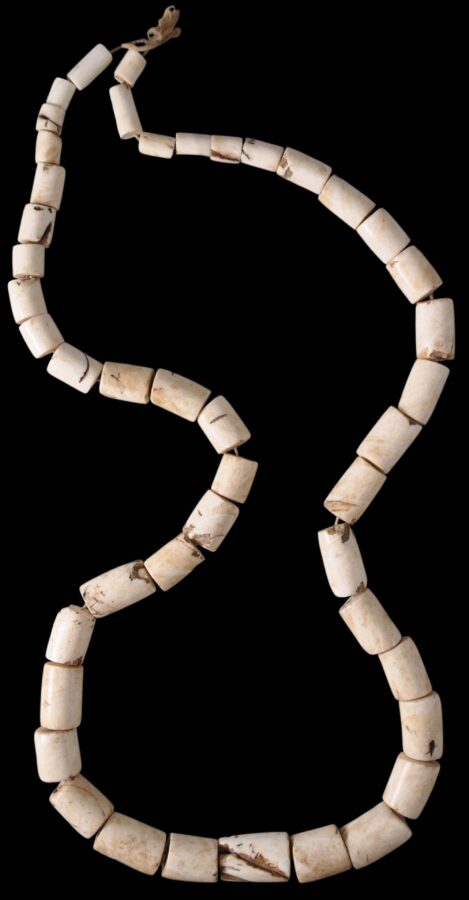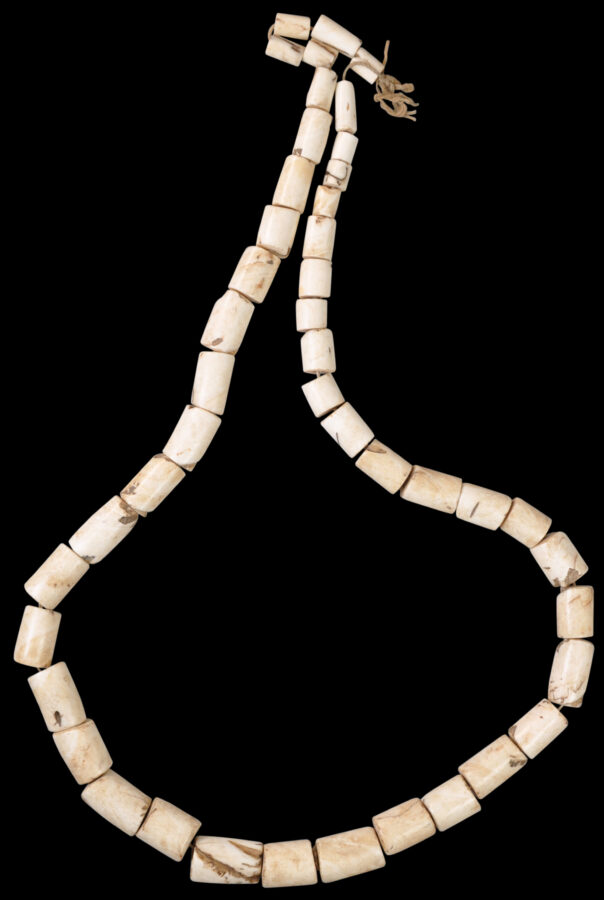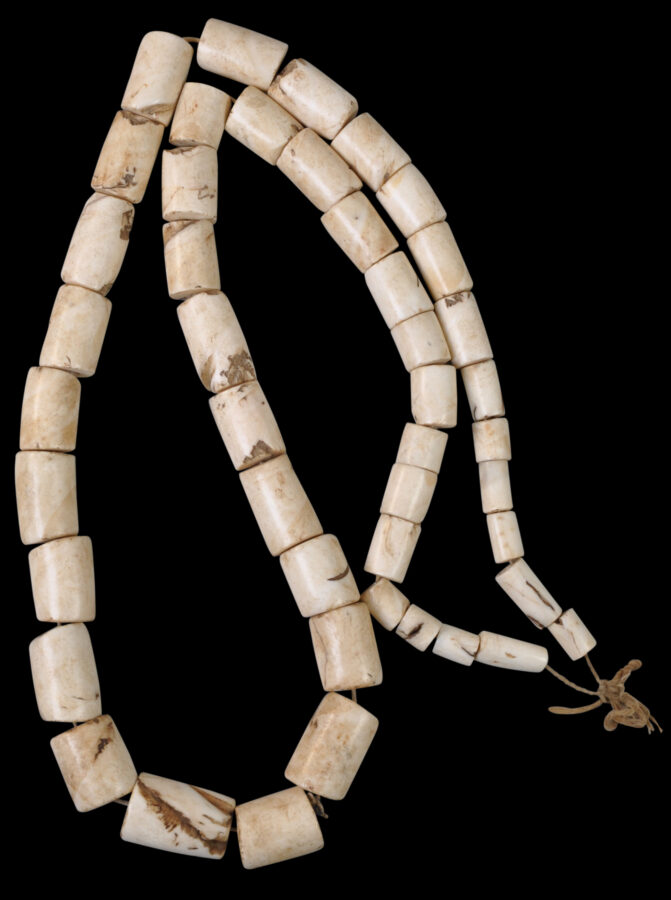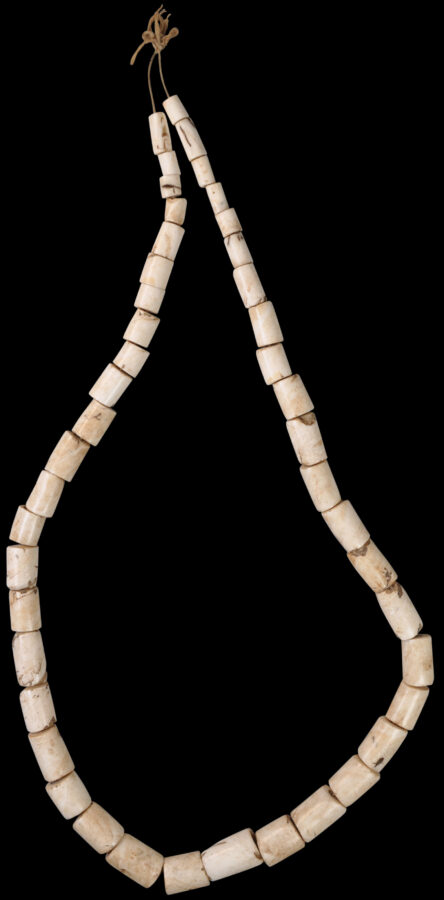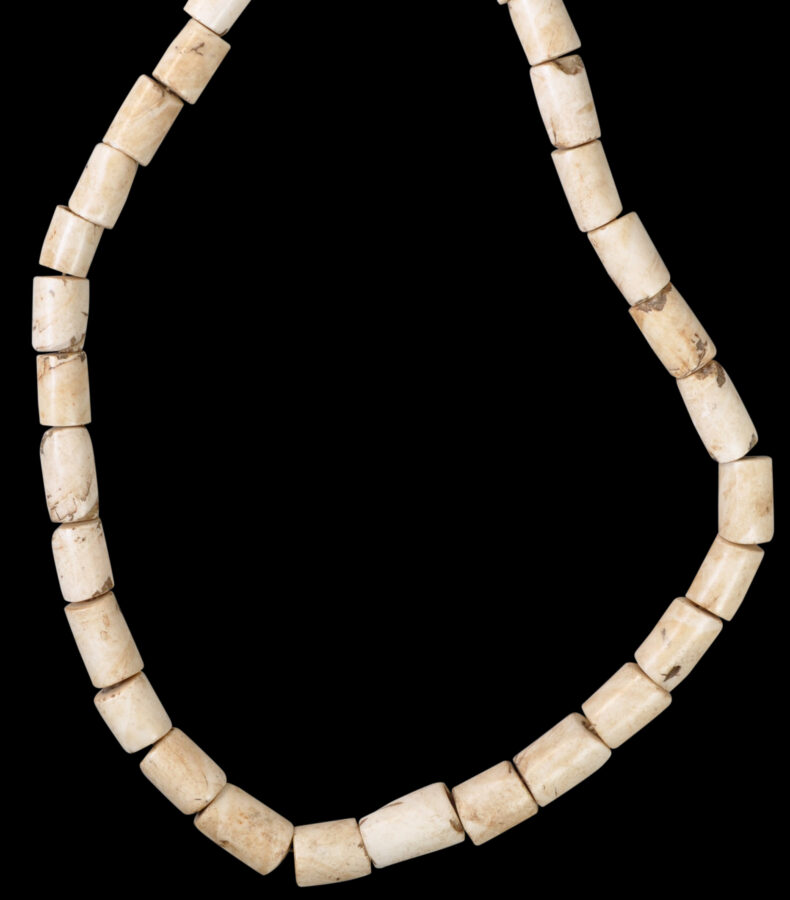Enquiry about object: 9849
Unusual & Massive Naga Shell Bead Necklace
Angami Naga People, North-Eastern India 19th-early 20th century
circumference: 101cm, length of beads: between 1.1 and 3.2cm, diameter of beads: between 1 and 2.1cm, weight: 531g
Provenance
Hansjorg Mayer Collection, UK
This striking necklace comprises large, graduated, barrel-shaped beads carved from chank shell. Its simplicity in terms of materials used and colour makes it particularly striking. Some of the beads have natural cavities, adding to their texture. There are 44 beads in total, and they retain their original stringing. It would have been reserved for important festival occasions on account of the expensive material from which it is made.
The barrel-shaped beads are unusual – Naga beads made from shell usually are more elongated and bicone in form.
Necklaces such as this example, composed of what were rare, expensive and imported items, were prestige pieces worn by the well-to-do to emphasise their status and wealth. The right to wear pieces composed of expensive, imported materials was earned and so the possession of such pieces was linked to status, hierarchy and achievement: the right to wear such ornamentation would be the aspiration of every young person in the tribe, and meant that social mobility could be earned. Jewellery items, like much else, were considered to have a spirit.
Such necklaces with large chank shell segments are typical of the Angami Naga of southern Nagaland. Usually, the shells used are referred to as conch shells but this is erroneous. The species used was in fact chank shells (Turbinella pyrum) sourced from the Indian Ocean and most probably in the case here, the Bay of Bengal. The shell is the same as that used in Buddhism and Hinduism and is referred to in this case as the sacred conch or shanka.
Beads produced from shells are part of the wider bead story in so far as the Naga are concerned.
According to Untracht (1997, p. 65), the Nagas ‘showed great discrimination when purchasing beads. They never bought irregular or low-quality beads and were fully prepared to pay the high price dealers demanded for beads of superior quality. Dealers knew this and sent only the best quality beads to Nagaland…’
The Naga people are concentrated in Eastern India. Smaller numbers are also in western Burma. The Naga themselves are divided into at least 15 major ethnic subgroups: the Angami, Ao, Chakhesang, Chang, Khiamniungan, Konyak, Lotha, Phom, Pochury, Rengma, Sangtam, Sümi, Tikhir, Yimkhiung, and the Zeme-Liangmai (Zeliang). They speak as many as 30 sometimes mutually unintelligible dialects. Traditionally, they were animists. Each group had their own ceremonial attire.
The area in India where the Nagas, who are believed to be of Mongolian descent, are concentrated was recognised as its own state, Nagaland, in 1977. It is a relatively remote, mountainous and landlocked region, but it was not remote from trade. The Nagas largely were farmers but general trade also was another economic activity, one in which both women and men participated. Costume and ornament making were a significant commercial activity. Some Naga tribes made no ornaments at all but instead bought them from other tribes.
The Naga appreciated imported glass beads and seashell components greatly for their jewellery and other adornment. Typically, the seashells were traded in from the Bay of Bengal. The beads came from India, and also much further afield such as Venice. Metal elements were also used. These were cast locally or imported, mostly from India. The Nagas traditionally were head hunters, and the jewellery of the menfolk reflected the preoccupation with ancestor worship and one’s prowess at hunting and taking heads.
Jewellery items were highly prized and were treated as heirlooms to be passed from family member to family member. Components of necklaces such as individual beads were prized just as much as overall jewellery pieces, and so often beads and other jewellery components would be used and re-used. Jewellery items would be amended and remade according to need and as a family’s wealth and prestige grew. But by the 1970s, the Nagas no longer wore much traditional jewellery and jewellery making for traditional purposes largely stopped. Most Nagas had also converted to Christianity (Baptist mostly), and the taking of heads had long stopped, having been largely supressed by the British in the early 20th century. As with any evolving society, heirloom pieces were traded for items that improved a family’s well-being – medicines, household appliances and so on.
The necklace here is from the collection of well known artist, printer and art publisher Hansjorg Mayer (b. 1943) who built up a large collection of Naga jewellery over a 50-year period, commencing in the early 1970s. Mayer’s works are to be found in the Tate Britain and other museums in Europe. Much of his collection was illustrated in the seminal book on the topic: Jacobs, J., The Nagas: Hill Peoples of Northeast India, Thames & Hudson, 1990.
The necklace here is illustrated on p. 327.
It is in excellent condition, with splendid age and patina.
References
Ao, A. S., Naga Tribal Adornment: Signatures of Status and Self, The Bead Society of Greater Washington, 2003.
Barbier, J.P., Art of Nagaland: The Barbier-Muller Collection Geneva, Los Angeles County Museum of Art, 1984.
Giehmann, M., Naga Treasures: Tribal Adornment from the Nagas – India and Myanmar, 2001.
Jacobs, J., The Nagas: Hill Peoples of Northeast India, Thames & Hudson, 1990.
Saul, J.D., The Naga of Burma: Their Festivals, Customs and Way of Life, Orchid Press, 2005.
Sherr Dubin, L., The Worldwide History of Beads, Thames & Hudson, 2009.
Shilu, A., Naga Tribal Adornment: Signatures of Status and Self, The Bead Museum, Washington, 2003.
Untracht, O., Traditional Jewelry of India, Thames & Hudson, 1997.


